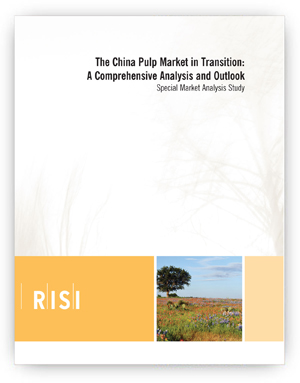 |
||||||||
| January 13, 2016 | ||||||||
| Improve boiler safety with a furnace inspection camera |  |
|||||||
|
· Subscribe to Ahead of the Curve · Newsletters · Ahead of the Curve archived issues · Contact the Editor
|
What is the future of BHK production in China? By Kurt Schaefer, VP Fiber, RISI There have been so many changes to the economic and industry outlook for China since 2012, when RISI published the first edition of its in-depth outlook for China, The China Pulp Market in Transition: A Comprehensive Analysis and Outlook. With the recent publication of the second edition of the report, it has been interesting to consider how well the results of the first study have held up. Here we focus on one major conclusion from the 2012 report, which was that, on the basis of the outlook for production costs in China relative to other major producing countries, "Market BHK production in China is not a sustainable business." In our view the past three years have supported this conclusion. The study contains analysis and forecasts for pulp production costs in China compared to other key countries. The analysis shows that China is now at the high end of the cost curve for BHK and that its competitive position can be expected to deteriorate further over time, unless the value of the renminbi drops sharply relative to the US dollar. (The renminbi is the official currency of the People’s Republic of China; the yuan is a unit of the renminbi.) That is certainly possible but is not our current base case forecast, which assumes instead that the slide in its value will be gradual rather than sudden. The reality on the ground in China is that a number of major BHK projects have been delayed indefinitely since 2012. The only major projects that have come on stream since then have been installed by integrated paper companies that will, either at startup or eventually, use the pulp for their own paper machines in China. The large suppliers of market BHK in China now producing market BHK have been intending to integrate that capacity forward into paper, but that process has been delayed because of slowing paper demand growth, which has contributed to low operating rates and depressed margins. The competitive outlook for these BHK mills is expected to remain challenging in the face of continuing BHK expansion in Indonesia and Brazil. Chinese mills have positive cash flow on an operating basis at current prices, but margins are not high. The owners will continue to seek a path to complete the integration of these mills into paper production, to the extent that conditions in the paper markets make that possible. For 2016 and onward, BHK capacity expansion plans are quite limited. Sun Paper should see an increase of 300,000 tonnes/yr of BHK capacity this year at its Yanzhou, Shandong Province, mill. This line currently makes dissolving pulp (DP), but production is expected to shift to BHK as Sun Paper ramps up its new DP line in Zoucheng, Shandong Province. The Zoucheng line started up in late October 2015. The switch at Yanzhou from DP to BHK has been postponed because the current gap between DP and BHK prices in China does not justify switching to BHK production at this time. Sun Paper will be using the Yanzhou line's BHK inside the company. Zoucheng is located a significant distance inland—unlike the mills at Rizhao, Haikou and Nantong—which raises its costs of using imported woodchips relative to the other large lines in China. The next new line is scheduled to come on stream in 2018. Chenming plans to build a 400,000-metric ton/yr BHK line at its location in Shouguang, Shandong Province. This will replace an old 150,000-metric ton/yr BHK line at the same location, which is scheduled to close before 2018. The pulp from the new line will be own-use pulp. There are no other BHK lines confirmed at present. As mentioned above, probably the key risk factor influencing the future viability of market BHK production in China is the value of the renminbi. Until very recently, the value of the Chinese currency was tightly pegged to the value of the US dollar. That means, of course, that the renminbi is now much stronger relative to other key pulp-producing currencies, such as the euro, the Brazilian Real, the Canadian dollar, and the pesos of Chile and Uruguay, than was the case two years ago. Pulp market participants usually talk about prices and costs in terms of US dollars. But with the USA now a small player in the BHK market, it can be helpful to leave the US currency out of the analysis and compare exchanges rates for China directly with those of the other key BHK pulp producers. Taking this approach makes it clear that, over the long run, the viability of market BHK production in China will depend in large part on how the value of the renminbi develops relative to these other, non-US currencies. In recent weeks the value of the renminbi has been declining significantly, and if this develops at a rapid pace—again, not our base case—then the economics of BHK production in China will receive a boost over time. Kurt Schaefer is RISI’s vice president, fiber, and author of the World Pulp Monthly and lead author of the new edition of The China Pulp Market in Transition: A Comprehensive Analysis and Outlook. He can be reached at kschaefer@risi.com. Now that you are Ahead of the Curve, stay there by joining TAPPI. |
|||||||
 |
||||||||

